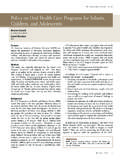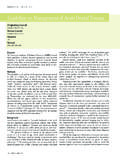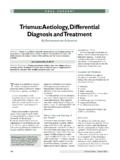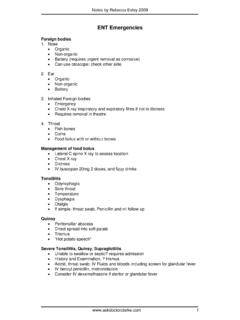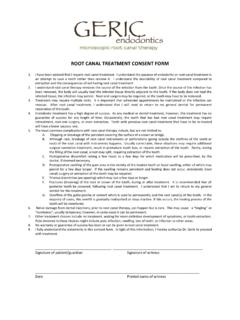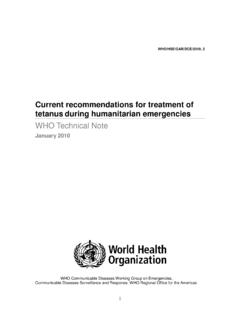Transcription of Guideline on Dental Management of Pediatric …
1 REFERENCE MANUAL V 37 / NO 6 15 / 16. Guideline on Dental Management of Pediatric Patients Receiving Chemotherapy, Hematopoietic Cell Transplantation, and/or Radiation Therapy Originating Committee Clinical Affairs Committee Review Council Council on Clinical Affairs Adopted 1986. Reaffirmed 1994. Revised 1991, 1997, 1999, 2001, 2004, 2008, 2013. Purpose Pediatric dentistry, AND practice Guideline ; Field: all; Limits: The American Academy of Pediatric Dentistry (AAPD) recog- within the last 10 years, humans, English, clinical trials, birth nizes that the Pediatric Dental professional plays an important through age 18. Sixty one thousand four hundred thirty two role in the diagnosis, prevention, stabilization, and treatment articles matched these criteria. One hundred thirty three papers of oral and Dental problems that can compromise the child's were chosen for review from this list and from the references quality of life before, during, and after cancer treatment.
2 Within selected articles. When data did not appear sufficient Dental intervention with certain modifications must be done or were inconclusive, recommendations were based upon promptly and efficiently, with attention to the patient's expert and/or consensus opinion by experienced researchers medical history, treatment protocol, and health status. and clinicians. Chemotherapy and/or radiotherapy for the treatment of cancer or in preparation for hematopoietic cell transplantation Background (HCT)* may cause many acute and long-term side effects in A multidisciplinary approach involving oncologists, nurses, the oral cavity. Furthermore, because of the immunosuppres- social workers, dieticians, dentists and other related health sion that patients experience, any existing or potential sources professionals is essential in caring for the child before, during of oral/ Dental infections and/or soft tissue trauma can com- and after any cancer The oral cavity is highly promise the medical treatment, leading to morbidity, mortality, susceptible to the effects of chemotherapy and radiation and and higher hospitalization costs.
3 It is imperative that the pedi- is the most frequently documented source of sepsis in the atric dentist be familiar with the medical history as well as oral immunosuppressed cancer For these reasons, early manifestations of the patient's underlying condition and the and definitive Dental intervention, including comprehensive treatment differences for patients undergoing chemotherapy oral hygiene measures, reduces the risk for oral and associated and/or radiotherapy and those who will receive HCT. systemic Acute oral sequelae as a result of cancer therapies and HCT. Methods regimens are common in children. 2 Oral and associated This Guideline is and update of the previous document adopted systemic complications may include pain, mucositis, oral in 1986 and last revised in 2008. The revision included a new ulcerations, bleeding, taste dysfunction, secondary infections systematic literature search of the PubMed electronic data- (eg, candidiasis, herpes simplex virus), Dental caries, salivary base using the parameters: Terms: Pediatric cancer, Pediatric gland dysfunction (eg, xerostomia), neurotoxicity, mucosal oncology, hematopoietic cell transplantation, bone marrow fibrosis, post-radiation osteonecrosis, soft tissue necrosis, transplantation, mucositis, stomatitis, chemotherapy, radiother- temporomandibular dysfunction (eg, trismus), craniofacial apy, acute effects, long-term effects, Dental care, oral health, and Dental developmental anomalies, and oral graft versus host disease (GVHD).
4 1,2,14. * The term HCT is also referred to as hematopoietic stem cell transplantation (HSCT). 298 CLINICAL PRAC TICE GUIDELINES. AMERICAN ACADEMY OF Pediatric DENTISTRY. All patients with cancer should have an oral examination surgical implantation or other active ,19 Due to prior to initiation of the oncology Prevention and the risk of antibiotic adverse events, development of drug treatment of pre-existing or concomitant oral disease is essential resistance among oral flora, spectrum of non-oral bacteria to minimize complications in this The key to causing catheter-related infections, and lack of evidence from success in maintaining a healthy oral cavity during cancer clinical trials, antibiotic prophylaxis is not necessary for therapy is patient compliance. The child and the parents patients with an indwelling central venous catheter who are should be educated regarding the possible acute side effects undergoing Dental procedures. 18,19 Immunosuppression is and the long-term sequelae of cancer therapies in the oral not an independent risk factor for nonvalvular device in- ,8,15-17 Because there are many oncology and HCT fections; immunocompromised hosts who have those devices protocols, every patient should be managed on an individual should receive antibiotic prophylaxis as advocated for basis; consultations with the patient's physicians and, when immunocompetent hosts.
5 18-21 Consultation with the child's appropriate, other Dental specialists should be sought before physician is recommended for Management of patients with Dental care is nonvalvular devices. Recommendations Dental history review: includes information such as fluoride Dental and oral care before the initiation of cancer therapy exposure, habits, trauma, symptomatic teeth, previous care, Objectives preventive practices, oral hygiene, and diet assessment. The objectives of a Dental /oral examination before cancer therapy starts are three-fold:16,17 Oral/ Dental assessment: should include thorough head, neck, To identify and stabilize or eliminate existing and poten- and intraoral examinations, oral hygiene assessment and tial sources of infection and local irritants in the oral training, and radiographic evaluation based on history and cavity without needlessly delaying the cancer treatment clinical findings. or inducing complications. To communicate with the oncology team regarding Preventive strategies the patient's oral health status, plan, and timing of Oral hygiene: Oral hygiene includes brushing of the teeth treatment.
6 And tongue two to three times daily with regular soft nylon To educate the patient and parents about the importance brush or electric toothbrush, regardless of the hematological of optimal oral care in order to minimize oral problems/ ,8,9,13,21,22 Ultrasonic brushes and Dental floss should be discomfort before, during, and after treatment and about allowed only if the patient is properly Patients with the possible acute and long-term effects of the therapy in poor oral hygiene and/or periodontal disease may use chlorhex- the oral cavity and the craniofacial complex. idine rinses daily until the tissue health improves or mucositis The high alcohol content of commercially-available Initial evaluation chlorhexidine mouthwash may cause discomfort and dehydrate Medical history review: should include, but not be limited to, the tissues in patients with mucositis; thus, an alcohol-free disease/condition (type, stage, prognosis), treatment proto- chlorhexidine solution is indicated in this situation.
7 Col (conditioning regimen, surgery, chemotherapy, radiation, transplant), medications (including bisphosphonates), allergies, Diet: Dental practitioners should encourage a non-cariogenic surgeries, secondary medical diagnoses, hematological status diet and advise patients/parents about the high cariogenic [complete blood count (CBC)], coagulation status, immuno- potential of dietary supplements rich in carbohydrates and suppression status, presence of an indwelling venous access oral Pediatric medications rich in line, and contact of oncology team/primary care physician(s).1. For HCT patients, include type of transplant, HCT source Fluoride: Preventive measures include the use of fluoridated (ie, bone marrow, peripheral stem cells, cord blood stem toothpaste or gel, fluoride supplements if indicated, neutral cells), matching status, donor, conditioning protocol, date of fluoride gels/rinses, or applications of fluoride varnish for transplant, and presence of GVHD or signs of transplant patients at risk for caries and/or xerostomia.
8 4,8 A brush-on rejection. The American Heart Association (AHA) recommends technique is convenient and may increase the likelihood of that antibiotic prophylaxis for nonvalvular devices, including patient compliance with topical fluoride indwelling vascular catheters (ie, central lines) is indicated only at the time of placement of these devices in order to prevent Trismus prevention/treatment: Patients who receive radiation surgical site The AHA found no convincing therapy to the masticatory muscles may develop trismus. Thus, evidence that microorganisms associated with Dental proce- daily oral stretching exercises/physical therapy should start dures cause infection of nonvalvular devices at any time after before radiation is initiated and continue throughout treat- implantation. 18-20 The infections occurring after device ment. Therapy for trismus may include prosthetic aids to reduce implantation most often are caused by staphyloccal Gram- the severity of fibrosis, trigger-point injections, analgesics, negative bacteria or other microorganisms associated with muscle-relaxants, and other pain Management ,5,10.
9 CLINICAL PRACTICE GUIDELINES 299. REFERENCE MANUAL V 37 / NO 6 15 / 16. Reduction of radiation to healthy oral tissues: In cases of to other therapies (eg, radiotherapy, surgery). The patient's radiation to the head and neck, the use of lead-lined stents, blood counts normally start falling five to seven days after prostheses, and shields, as well as salivary gland sparing tech- the beginning of each cycle, staying low for approximately niques (eg, three-dimensional conformal or intensity modulated 14 to 21 days, before rising again to normal levels for a radiotherapy, concomitant cytoprotectants, surgical transfer few days until the next cycle begins. Ideally, all Dental care of salivary glands), should be discussed with the radiation should be completed before cancer therapy is initiated. oncologist. When that is not feasible, temporary restorations may be placed and non-acute Dental treatment may be delayed Education: Patient/parent education includes the importance until the patient's hematological status is ,5,8,10,11.
10 Of optimal oral care in order to minimize oral problems/ Prioritizing procedures: When all Dental needs cannot be discomfort before, during, and after treatment and the possible treated before cancer therapy is initiated, priorities should acute and long-term effects of the therapy in the craniofacial be infections, extractions, periodontal care (eg, scaling, prophylaxis), and sources of tissue irritation before the treatment of carious teeth, root canal therapy for perma- Dental care nent teeth, and replacement of faulty ,14. Hematological considerations14: The risk for pulpal infection and pain determine which Absolute neutrophil count (ANC): carious lesions should be treated Incipient to small >2,000/mm3: no need for antibiotic prophylaxis;1,10 carious lesions may be treated with fluoride and/or 1000 to 2000/mm3: Use clinical judgment1 based on sealants until definitive care can be It is the patient's health status and planned procedures.



